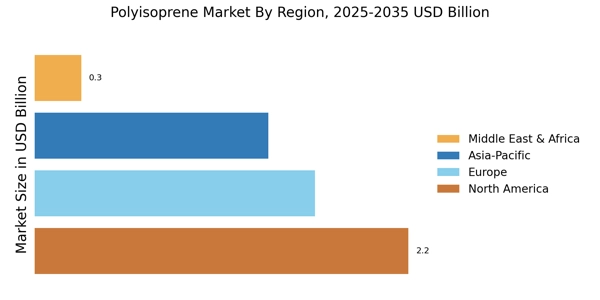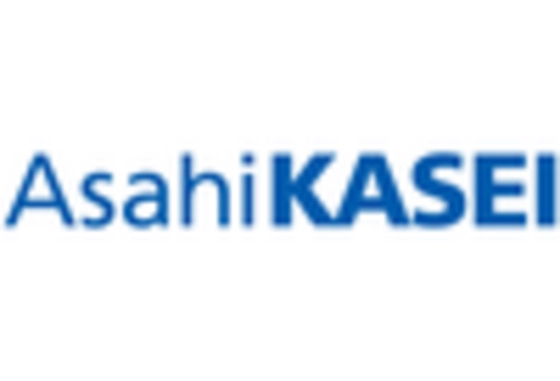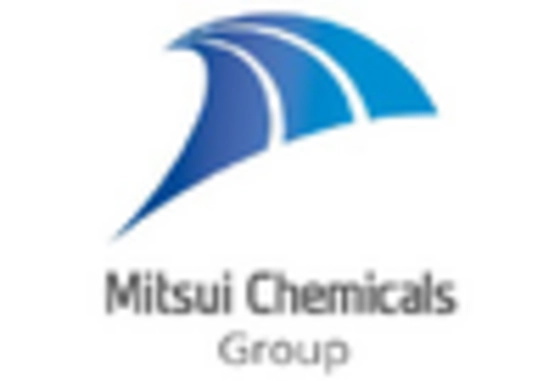Rising Demand for Eco-Friendly Products
The increasing consumer preference for sustainable and eco-friendly products is a pivotal driver in the Polyisoprene Market. As environmental awareness grows, manufacturers are compelled to adopt materials that align with these values. Polyisoprene Market, being a synthetic rubber derived from renewable resources, presents a viable alternative to traditional petroleum-based rubbers. This shift is reflected in market data, indicating a projected growth rate of approximately 5% annually in the demand for eco-friendly materials. Companies are investing in research and development to enhance the properties of polyisoprene, making it suitable for various applications, including automotive and medical sectors. The Polyisoprene Market is thus witnessing a transformation, as businesses strive to meet the evolving expectations of environmentally conscious consumers.
Regulatory Support for Sustainable Materials
Regulatory frameworks promoting the use of sustainable materials are emerging as a crucial driver in the Polyisoprene Market. Governments are increasingly implementing policies that encourage the adoption of eco-friendly materials in various industries, including construction, automotive, and consumer goods. These regulations often provide incentives for companies that utilize sustainable materials, thereby fostering innovation and investment in the polyisoprene sector. As a result, the Polyisoprene Market is likely to benefit from enhanced market access and reduced barriers to entry, facilitating growth and expansion. The alignment of regulatory support with market trends suggests a promising future for polyisoprene as a preferred material.
Growth in Automotive and Medical Applications
The expanding applications of polyisoprene in the automotive and medical sectors are driving growth in the Polyisoprene Market. In the automotive sector, polyisoprene is increasingly utilized for tire manufacturing and various components due to its excellent elasticity and durability. Similarly, in the medical field, polyisoprene is favored for its biocompatibility and resistance to degradation, making it ideal for products such as gloves and catheters. Market analysis indicates that the automotive segment alone is expected to account for over 30% of the total polyisoprene consumption by 2026. This diversification of applications is propelling the Polyisoprene Market forward, as manufacturers seek to capitalize on these lucrative opportunities.
Increased Investment in Research and Development
The surge in investment in research and development within the polyisoprene sector is a significant driver of the Polyisoprene Market. Companies are allocating substantial resources to innovate and improve the properties of polyisoprene, aiming to enhance its performance in various applications. This focus on R&D is expected to yield new formulations and products that meet the evolving needs of consumers and industries. Market data indicates that R&D spending in the synthetic rubber sector is projected to grow by approximately 10% annually, reflecting the industry's commitment to innovation. As a result, the Polyisoprene Market is poised for advancements that could redefine its applications and market potential.
Technological Innovations in Production Processes
Technological advancements in the production processes of polyisoprene are significantly influencing the Polyisoprene Market. Innovations such as improved polymerization techniques and the development of more efficient catalysts are enhancing the quality and performance of polyisoprene. These advancements not only reduce production costs but also minimize environmental impact, aligning with sustainability goals. Market data suggests that the adoption of these technologies could lead to a reduction in production costs by up to 15%, thereby making polyisoprene more competitive against other synthetic rubbers. As manufacturers embrace these innovations, the Polyisoprene Market is likely to expand, catering to a broader range of applications and industries.


















Leave a Comment